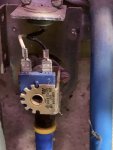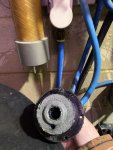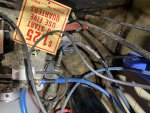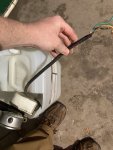So ya know full and system is off but water trickles out the whole in tank where power cord enters tank for float.The float at the top tells the system when the tank is full and to stop adding product.
The float at the bottom tells the system that sends the water to the bays to shut off if the water level gets too low so you don’t damage the pump.
Is your RO system running when this water continually pours out? Or is the system off?
Car Wash Forum
You are using an out of date browser. It may not display this or other websites correctly.
You should upgrade or use an alternative browser.
You should upgrade or use an alternative browser.
Need Help. Please. I own a Reverse Osmosis Machine from 1989
- Thread starter Rookie68
- Start date
So ya know full and system is off but water trickles out the whole in tank where power cord enters tank for float.
Ok then it’s like MEP001 said, it’s likely the solenoid on the incoming water supply that is bad and letting water through even when it’s off.
New membrane installed 4-18-2022
still waiting on new float switch to arrive.
I see no solenoid on incoming water line.
Flow goes out main into water softener into pre filter into pump into membrane from top out the bottom then back into membrane and finally into holding tank until it’s pumped out the bottom by the delivery pump. Still have a steady leak out the hole for the cord of float switch.
still waiting on new float switch to arrive.
I see no solenoid on incoming water line.
Flow goes out main into water softener into pre filter into pump into membrane from top out the bottom then back into membrane and finally into holding tank until it’s pumped out the bottom by the delivery pump. Still have a steady leak out the hole for the cord of float switch.
Attachments
-
 478444B4-DCA1-47D3-987F-DA9DFC5E40B1.jpeg1.4 MB · Views: 28
478444B4-DCA1-47D3-987F-DA9DFC5E40B1.jpeg1.4 MB · Views: 28 -
 EBC4860C-9E20-4618-8487-00D7EBF314AB.jpeg1.8 MB · Views: 26
EBC4860C-9E20-4618-8487-00D7EBF314AB.jpeg1.8 MB · Views: 26 -
 57E2141A-65EA-43BC-B6A4-299A34F2A896.jpeg2.7 MB · Views: 26
57E2141A-65EA-43BC-B6A4-299A34F2A896.jpeg2.7 MB · Views: 26 -
 4EF51D07-0CC3-4120-96DC-FB72291E9925.jpeg1.7 MB · Views: 27
4EF51D07-0CC3-4120-96DC-FB72291E9925.jpeg1.7 MB · Views: 27 -
 image.jpg1.9 MB · Views: 27
image.jpg1.9 MB · Views: 27 -
 image.jpg2.1 MB · Views: 26
image.jpg2.1 MB · Views: 26
Cool. That is the one i ordered last week. should be here any day.This one is configurable for both open-on-rise and close-on-rise, so it will replace either one.
RO Storage Tank Float Switch
RO Storage Tank Float Switch for high or low water cutoff, with 24V or 120V operation.www.kleen-ritecorp.com
Oh the error in my ways !!!
It hit me today. When I replaced the motor and pump I had the Electrical Shop I ordered the motor from put a longer cord on my pump.
The previous owners had the pump (and Selenoid) wired to the same plug as the motor via wire nuts. I thought this was due to a lack of outlets in the room. Now, I realize this may not have been the case at all. IE.... when the Motor turned on the Selenoid opened. When the motor shut off the selenoid shut. Once again I am the cause of my own frustration. So, hell... It may not be a bad float or a bad Selenoid. Its just that someone has em wired wrong now....
A. Does this make sense ?
B. Best way to replicate what was there before a bit more safely than just live wires with wire nuts in my wet equipment room ?

It hit me today. When I replaced the motor and pump I had the Electrical Shop I ordered the motor from put a longer cord on my pump.
The previous owners had the pump (and Selenoid) wired to the same plug as the motor via wire nuts. I thought this was due to a lack of outlets in the room. Now, I realize this may not have been the case at all. IE.... when the Motor turned on the Selenoid opened. When the motor shut off the selenoid shut. Once again I am the cause of my own frustration. So, hell... It may not be a bad float or a bad Selenoid. Its just that someone has em wired wrong now....
A. Does this make sense ?
B. Best way to replicate what was there before a bit more safely than just live wires with wire nuts in my wet equipment room ?

MEP001
Well-known member
At least now you know why the tank is overfilling.
The motor and solenoid were originally wired directly together. It doesn't matter where you make the connection as long as it's safe. I think it originally had the wires connected in the motor and continuing through to the solenoid, but it should be easier to make the connections under the solenoid cover and continue the line to the pump. You could also drill another hole in the control box and run another cable from there to the solenoid.
The motor and solenoid were originally wired directly together. It doesn't matter where you make the connection as long as it's safe. I think it originally had the wires connected in the motor and continuing through to the solenoid, but it should be easier to make the connections under the solenoid cover and continue the line to the pump. You could also drill another hole in the control box and run another cable from there to the solenoid.
Yes agreed. But how is what you are suggesting different than just having them both plugged in individually as I am now ? The motor and the pump each are plugged in individually. The motor plugs into a female cord coming out of the “brains” of the RO machine. The pump and solenoid are plugged directly into the wall. Previously the pump was spliced into the same power cord the motor used. So I gather that the solenoid is regularly closed and when the RO machine sent juice down the line to turn the motor on (and the pump) it also sent a jolt to the solenoid which causes it to open. Then, when pump shut off, the solenoid current is also killed and it closes again. Damn, this was an expensive lesson and it’s still not fixed. I appreciate everyone who offered me insight along the way.At least now you know why the tank is overfilling.
The motor and solenoid were originally wired directly together. It doesn't matter where you make the connection as long as it's safe. I think it originally had the wires connected in the motor and continuing through to the solenoid, but it should be easier to make the connections under the solenoid cover and continue the line to the pump. You could also drill another hole in the control box and run another cable from there to the solenoid.
MEP001
Well-known member
You should have two plugs. One is for the pump for the bays, which should have its own plug. The other is for the whole production side. The inlet solenoid gets power from the same source as the motor, it doesn't matter where it hooks up as long as this relay turns on both the motor and the solenoid.

For clarity, what you're calling the pump is the delivery pump/motor assembly for the bays, aka the delivery pump. What you're calling the motor is also a pump/motor assembly, it's just a different kind, and it's for the membrane, usually called the production pump.

For clarity, what you're calling the pump is the delivery pump/motor assembly for the bays, aka the delivery pump. What you're calling the motor is also a pump/motor assembly, it's just a different kind, and it's for the membrane, usually called the production pump.
I understand that I have two different pumps as you stated. The motor and pump I’m referring to feed the RO system. My delivery pump that feeds the bay is mounted below on the same rack. I appreciate you defining these for me.You should have two plugs. One is for the pump for the bays, which should have its own plug. The other is for the whole production side. The inlet solenoid gets power from the same source as the motor, it doesn't matter where it hooks up as long as this relay turns on both the motor and the solenoid.
View attachment 5839
For clarity, what you're calling the pump is the delivery pump/motor assembly for the bays, aka the delivery pump. What you're calling the motor is also a pump/motor assembly, it's just a different kind, and it's for the membrane, usually called the production pump.
Not doubting your expertise but how do you know that? I’m still learning.This one is configurable for both open-on-rise and close-on-rise, so it will replace either one.
RO Storage Tank Float Switch
RO Storage Tank Float Switch for high or low water cutoff, with 24V or 120V operation.www.kleen-ritecorp.com
MEP001
Well-known member
It says so in the description.Not doubting your expertise but how do you know that? I’m still learning.



